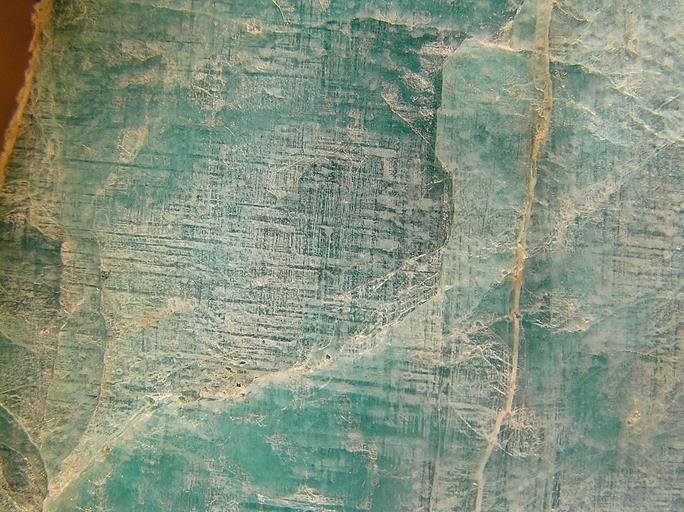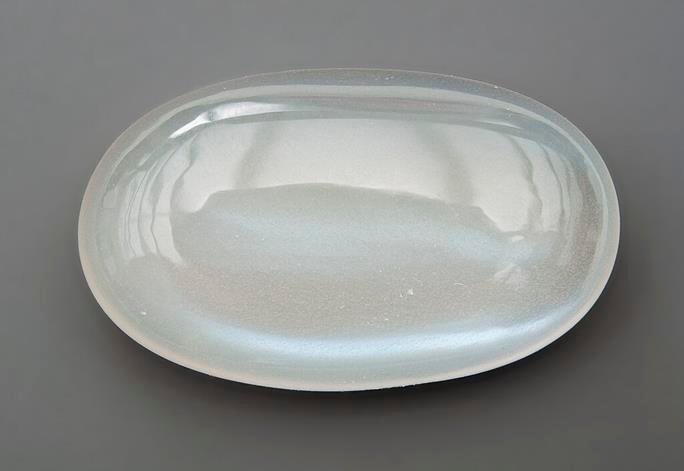Perthite describes an intimate intergrowth of alkali feldspars, in which sodium plagioclase lamellae, blebs, or droplets exsolve in potassium feldspar.
To exsolve means to umix or segregate an initially homogenous solution into various components. It happens due to changes in conditions like pressure and temperature.
Both potassium feldspar (K-feldspar) and sodium plagioclase (Na-plagioclase) are alkali feldspars. At the same time, Na-plagioclase is also a plagioclase.
K-feldspars include orthoclase, sanidine, microcline, and anorthoclase, with microcline showing a higher tendency to form visible lamellae than orthoclase.
On the other hand, sodium plagioclase is usually albite and oligoclase, with the former being the one that often exsolves.
The resultant texture or fabric formed when sodium plagioclase exsolves in potassium feldspar is known as perthitic texture or fabric.
Most perthitic fabrics are visible with a microscope. However, some are visible in hand specimens with unaided eyes, while others are submicroscopic, i.e., not visible to a microscope.
Lastly, perthite is named after Perth, a town in Ontario, Canada, where this texture was first observed.

What does perthite mean?
Perthite is an alkali feldspar intergrowth in which sodium plagioclase, usually albite and less often oligoclase lamellae, exsolves in potassium feldspar, usually microcline but sometimes orthoclase.
In a perthite intergrowth, the dominant alkali feldspar hosts the exsolve sodium plagioclase (guest). The original homogenous mixture was K-feldspar rich, and most layers in this intergrowth are K-feldspar.
Put differently, exsolved Na-plagioclase lies within the host microcline or orthoclase grains.
The exsolved or guest albite or, less often, oligoclase can appear as blebs, strings, irregular patches, or lamellae subparallel to a certain crystallographic plane. Also, veinlike, braided, or netlike structures occur.
You can name perthites using the dominant or host alkali feldspar. For instance, orthoclase or microcline perthite means they are the dominant alkali feldspar, respectively.
Lastly, perthites can have various colors due to light interference. This can include pink, honey, and red, with some showing golden labradorescence on a flesh-red, white, or reddish-brown background. Some can show silvery reflection or blue-white fluorescence.
Note: Perthite lamellae aren't the same as twin lamellae. It is possible to differentiate these two via thin-section observation. Perthite lamellae will have an irregular boundary, while in twin, it is straight like a rule.
Antiperthite
Antiperthite is an intergrowth where K-feldspar lamellae exsolve in sodium plagioclase like albite or Ca-bearing plagioclase.
The host or dominant phase in antiperthite is sodium plagioclase. Therefore, the homogenous solution was Na-rich.
Lastly, antiperthitic textures occur but are less common compared to perthitic.

Mesoperthites
Mesoperthite describes a perthite intergrowth with nearly equal amounts of sodium plagioclase and alkali feldspars. It is common in granulites and charnockites
Where does it occur
Perthite intergrowth occurs in mostly plutonic and high-grade metamorphic rocks. However, it can occur in volcanic rocks but will be on a submicroscopic.
This intergrowth is common in felsic or acidic igneous rocks and gneisses. Also, it occurs in rocks in granulite facies and metamorphosed argillaceous rocks.
Lastly, rocks crystallized under low water vapor, i.e., hypersolvus rocks, including granites, syenites, etc., and pegmatites tend to show pronounced perthitic texture.
Perthite classification
Classification is according to the size of the exsolve phase, usually albite and less often oligoclase.
The intergrowths can be macroperthite, microperthite, and cryptoperthite. This size depends on the cooling rates and other factors.
1. Macroperthite
In microperthite, the perthitic texture is visible by an unaided eye. On a hand specimen, you can see the intergrowth characterized by large masses or lamellae of Na-plagioclase in K-feldspar.
It is common in plutonic and some high-grade metamorphic rocks that cool slowly. A common example is amazonite, whose perthitic structure is visible with an unaided eye.

Perthite Amazonite | Ronald Werner, CC BY-SA 4.0, via Wikimedia Commons.
2. Microperthite
Microperthite intergrowths of alkali feldspar and exsolved Na-plagioclase are only visible or resolved in thin sections using a microscope. A hand specimen will appear homogenous.
This texture occurs when cooling is relatively slow and is common in some plutonic or high-grade metamorphic rock.
3. Cryptoperthite (submicroscopic)
Cryptoperthite has extremely fine lamellae of Na-plagioclase exsolved in K-feldspar, only detectable with X-ray diffraction or an electron microscope.
This submicroscopic intergrowth of alkali feldspars is common where cooling is rapid, like in volcanic rocks.
An example is moonstone, whose perthitic structure you cannot see even with a microscope.

Note: You can use compositional and scale terms like cryptomesoperthite. Such indicates nearly equal K-feldspar and Na-plagioclase with submicroscopic lamellae.
Why do perthites form?
Disordered K-feldspar and Na-plagioclase can exist as a single homogenous solid solution at higher temperatures. This is preserved at room temperature when rapidly cooled, such as in lavas.
However, the miscibility of these alkali plagioclases decreases as the temperature falls. This happens because, on cooling, the allowed sodium in K-feldspar and potassium ions in Na-feldspar decrease.
The decrease results from differences in sodium and potassium ion radii, which causes chemical decomposition.
Therefore, sodium plagioclase will unmix or segregate from homogenous feldspar on slow cooling and form subparallel lamellae in K-feldspar.
This exsolution forms perthite intergrowth with K-feldspar (orthoclase or microcline) with Na-rich feldspar lamellae, usually albite and less oligoclase.
Usually, the exsolution process involves solid-state diffusion of Na and K ions. These ions diffuse against a concentration gradient, i.e., from low to high.
However, since silicon (Si) and aluminum (Al) diffusion is sluggish, the intergrowth may have Si-Al disorders.
Factors that affect perthitic texture growth are temperature and vapor pressure, while the Na to K ratio affects the temperature at which it begins.
When cooling is slow, like in plutonic rocks or some high-grade metamorphic, it favors the formation of feldspar intergrowth that is visible with a microscope or even an unaided eye and is extensive in very high water pressures.
On the other hand, rapid cooling will result in submicroscopic lamellae exsolution or cryptoperthitic texture.
Lastly, the intergrowths are mostly on scales of a few mm. However, later dissolution-precipitation reactions in aqueous fluids may partially or completely modify and make them coarser.
Plagioclase intergrowths
Plagioclase feldspars also have intergrowth but occur only on an extremely fine scale compared to alkali feldspars.
The entire albite-anorthite series occurs as a homogenous stable solid at high temperatures. At lower temperatures, these various plagioclase feldspars undergo microscopic exsolution.
Some of the complex important intergrowths are Bøggild, peristerites, and Huttenlocher.
This exsolution will cause a play of color or the Shiller effect. For instance, a labradorite hand specimen may show a bluish Shiller effect.
Lastly, we ignore their presence since plagioclase intergrowths occur on a very fine scale. Why? Because it doesn’t affect overall plagioclase properties, i.e., plagioclase properties remain more or less the same as in homogenous solutions.
Perthitic textures effects
Perthitic texture or intergrowth can cause iridescences and the Shiller effect or play of color. Some create very attractive color effects.
They occur due to light interference or diffraction from the K-feldspar and Na-plagioclase boundaries and are important in identifying some minerals.
For instance, microscopic exsolved lamellae in perthite or antiperthite will give a Schiller effect or play of color to mineral grain.
Shiller can help identify minerals because the microscopic (very fine or minute) exsolved lamellae cause light interference.
On the other hand, moonstone, an alkali feldspar, shows diffuse milky whitish to pale bluish iridescence due to light interference by submicroscopic lamellae.
Uses
The light interference in perthites can help identify some minerals.
Also, some colorful minerals like those labradorescence or Schiller effects are valuable gemstones, including those cut en cabochon.
Lastly, some make parts of jewelry like pendants, brooches, earrings, etc., and ornamental items like carvings.
